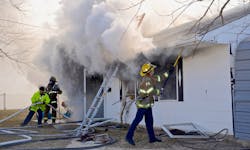On The Cover: Firefighter Rescue
The prolonged record-cold winter of 2015 contributed to taking a toll in Prince George’s County, MD, on the afternoon of Feb. 15, 2015.
At 1:43 P.M., the Prince George’s County Public Safety Communications Center (PSCC) received a 9-1-1 call reporting a fire in a house on South Lawn Drive in the Oxon Hill area of the county. A standard Prince George’s County, MD, Fire/EMS box alarm consisting of four engines, two ladder trucks, a rescue squad, two battalion chiefs and an ambulance was dispatched. The rescue squad and one engine reported staffing of three; all other units reporting staffing of four or more. The normal radio-controlled “status messaging” was out of service, resulting in manual-verbal staffing and scene status reporting.
This location is only a few blocks away from the Oxon Hill Station 821. Engine 821 and Paramedic-Ambulance 821 arrived at 1:46. Engine 821 “passed command,” reporting “smoke showing” from a 1,100-square-foot, single-family house built on a concrete slab. Temperatures struggled to reach 15 degrees with steady 25-mph winds gusting to as much as 35 mph. Wind travel was generally blowing into the front A/D corner of the house, driving the super-heated gases through the house to and eventually out the rear B and C quadrants.
“Working fire dispatch”
Command was established by Volunteer Chief 842-A, Napoleon Epps. The “working fire dispatch” was sent, bringing a paramedic unit, the safety officer, the EMS duty officer and the Rehab Bus. Given smoke-only showing, command initially directed units to operate with the first two engines and the first-due truck, directing the other units to stage/standby outside.
Due to obstructions, including an addition to the property line, fencing and debris, a full 360-degree walk-around size-up could not be completed by the first-in officer. Crews were able to observe the majority of the smoke coming from the eaves at the A/B quadrants. The homeowner was busy chasing down their loose dog – making a more thorough initial size-up, including verbal verification of additional occupants and important intelligence about fire location, impossible to ascertain. The first engine officer (Engine 821) directed his crew into the front door and to the left living room/kitchen area, where he believed the fire was located, based on the exterior issuance of smoke.
During this attempt at locating the fire, the first-arriving special service crew (Rescue Squad 847) split into two teams; a two-person inside and a two-person outside team. The inside team, working with Engine 821, was responsible for search, rescue and interior ventilation. The outside team was responsible for exterior ventilation, ladders, utility tasks, etc. when appropriate. By now, the fire had vented from its room of origin and out the exterior windows on the rear at the C/D side – however, the obstructions noted made this observation invisible to crews operating.
Fire located
A two-person truck crew with a captain operating in quadrants C/D located the fire in a back bedroom. The Captain and an engine crew were unsuccessfully attempting to stretch a hoseline down the hallway toward the fire room in quadrant C/D. This location, now identified as the location of origin, was directly opposite the location of the first attack line deployment – remember the decision to originally deploy towards the A/B quadrants was made based upon the limited size-up showing smoke issuing from the A/B roof eaves.
As the rear windows failed and front windows were opened, an instantaneous flow path, pushed by strong winds hitting the A/D sides of the home, was created. Shortly after this, high heat and smoke began to consume all quadrants of the structure.
The new flow path placed the captain and this engine crew in a tenuous location, ultimately resulting in the captain receiving second-degree burn injuries. All members of the crew were able to self-extricate themselves from that situation as an evacuation order was sounded.
Evacuation order
Simultaneously, the increase in super-heated smoke in all quadrants is believed to have precipitated a firefighter opening a backup line to cool the super-heated environment. That hoseline struck the head of a different engine company lieutenant, dislodging his facepiece.
Due to deteriorating conditions, at 1:57, an evacuation order was sounded by command. Fortunately, the experienced lieutenant who had been struck by the hoseline was within 10 feet of the front door and was able to remember his path of travel to the front door. The lieutenant managed to exit the home on his own, collapsing at the front door before additional harm could have been caused. Additional crew members assisted the lieutenant away from the structure (see cover photo) to be evaluated by EMS crews standing by. The lieutenant was transported to a local hospital, where he was treated and released, miraculously unharmed.
After personnel accountability report (PAR) checks were completed, all crews were directed to re-group and develop a plan for re-entry, extinguishment, search and overhaul. There were anxious moments as one firefighter from the captain’s team was listed as unaccounted for. The captain, unaware of his burn injuries, re-entered to locate the missing firefighter. Within a matter of seconds, the firefighter was located safe outside. An additional engine and ladder truck were special-called for rehab and relief. Temperatures at 15 degrees with 25 mph winds will take a toll on the most seasoned firefighter.
Fire extinguished
After the regroup and re-evaluation of the scene, crews systematically extinguished the bulk of the fire from the exterior, then re-entered to complete overhaul and extinguishment. After PGFD fire investigators completed their on-scene evaluation, the last units left the scene at 6:48 P.M. – a full five hours after the initial dispatch. The cause of the fire was determined to be combustibles too close to a heater, with a property loss of $80,000.
The captain and lieutenant were both transported to the hospital for evaluation and treatment. Both have since returned to full duty. No occupants were located inside the home.
Safety investigation & incident review
The initial incident reviews and internal safety investigation have been completed. This included on-scene tailboard critiques, on-going battalion reviews and drills and the formal collection of burned gear, crew statements and investigations. At the time of this writing, a formal safety investigation was being considered. Once a decision is made on the formal safety investigation, the PGFD will share our results with the fire service.
There were significant programmatic and climatic issues at this scene contributing to an initial impression and reality of chaos. Except for the fact that everyone went home, this was not one of our department’s shining moments. I know, the story sounds like an eternity and a calamity. Everything above occurred in the first five to seven minutes of first and subsequent arriving units.
Radio communications were likely made difficult for command to hear, partially due to the decision to locate the command post in the front yard. There were multiple unanswered calls over the radio – transmissions likely made unintelligible due to the strong winds blowing, coupled with the typical fire scene activities. Several crews acted alone, without a coordinated plan provided by command.
This incident provided a classic example of the need for changing strategy and tactics involving wind-driven fires. Although the flow-path science has now become “gospel” for the PGFD, clearly there is significant training and tactical understanding needed. It is imperative that command officers locate their “10-by-10 box” for their command post, whether that is a vehicle, the back of a SUV or a position in the front yard, the static command post is essential to proper command and control functionality. Command officers must formulate and articulate a plan to responding and on-scene units. It is equally important for company officers to ensure that orders are followed and actions are coordinated through a systematic approach to the firefight.
This was indeed a close call – it is our desire to learn from our mistakes, while helping ourselves and others stay safe.
MARC S. BASHOOR, with 33 years of emergency service experience, has been fire chief of Prince George’s County, MD, Fire/EMS for the past four years.
pull quote:
This incident provided a classic example of the need for changing strategy and tactics involving wind-driven fires.
About the Author

Marc S. Bashoor
MARC S. BASHOOR joined the fire service in 1981. In 2017, he retired as fire chief of Prince George’s County, MD, Fire/EMS, the largest combination department in North America. His progressive community-based approach led to record hiring and a strategic apparatus replacement plan.
Twitter: @ChiefBashoor
Email: [email protected]
